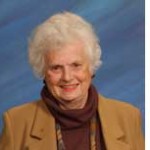Natasha’s Memoirs

LA JOLLA, California — In 1962, I joined Trude Lash, Director of the Citizens Committee for Children of New York, Inc., investigating various children’s facilities. I visited daycare services, settlement houses, shelters for dependent and neglected children, detention facilities, pediatric wards, and state hospitals.
While at the last, I discovered “well babies,” so named because they were abandoned at birth by mothers who never returned to pick them up and were nowhere to be found. Sick babies in the hospitals required care, so short-staffed nurses did not have time to hold and nurse the “well babies.” Bottles were propped up and only infrequent interactions for diaper changes or bathing occurred. Some of these babies were there for up to a year.
I knew of John Bowlby’s work on attachment theory; he was a British psychologist and psychoanalyst who theorized that children have an innate need to bond with a primary figure, usually the mother. Without a such a person, the baby’s emphasis is on survival. He noted that the first twelve months of life are the most critical period for the child. Without this attachment, children are unable to care emotionally for others. Failure to thrive results in cognitive decline and the inability to feel empathy. Long-term consequences include impulsiveness, aggression, depression, delinquency, and reduced intelligence levels.
Similarly, René Spitz, an Austrian-American psychoanalyst, had introduced the term hospitalism, a diagnosis for disorders in infants who were institutionalized for long periods and deprived of substitute maternal care, causing irreparable psychological damage. This is what I witnessed in the hospitals I visited. The same can be said for all children separated from primary care givers. The longer they are kept away, the more severe the damage.
I wanted to do something about this unacceptable situation. At the time, Jim Dumpson was the Commissioner of the New York City Department of Welfare. In order to qualify for temporary foster care an infant had to be in a home with two parents and suitable accommodations. I suggested to him that all an infant a few weeks old needed was a warm mother figure and a laundry basket or drawer as a bed. He agreed that if within three days the biological mother could not be found, the infant would go to such a setting.
To this end, Trude Lash and the committee advertised for foster mothers in buses and subways. We received many inquiries. We accepted women on ADC (Aid for Dependent Children) who would be paid to care for these infants. Most of these babies were from poor families. During my home studies, I found many wonderful, warm-hearted women happy to mother these babies until more permanent solutions could be found. Sixty years later, this program is still in place, having saved thousands of babies from developmental damage.
This early success made me want to pursue a professional degree. The Columbia University School of Social Work was then located in a large mansion on 5th Avenue. The cutoff age to apply was 36 years old; I was 35 and ten months. They admitted me to a two-year master’s program as their oldest student ever.
In addition to the class requirements, there was an internship each year. My first internship was at the Spence Chapin Adoption Agency. The work included going to hospitals to meet mothers who had just given birth. They were mostly teenage girls unable to take on the responsibility of raising a child. Giving up a baby was always done with the birth mother’s full consent and hope that her child would have a better life. We often cried together as I left carrying their babies away.
I also did home studies of parents waiting to adopt. I was always warmly greeted with a just-baked cake. I participated in the staff meetings at Spence Chapin to determine which baby would best fit into which family. The most exciting day was when I finally brought a baby to the new parents’ waiting arms; there were often tears of joy. My follow-up home visits were to assess that both parents and baby were happy and adjusting well.
My second internship was at the Mount Sinai Hospital psychiatric department where I saw patients in the hospital and also continued their care after their release. This experience was invaluable in my subsequent work with clients.
I graduated in 1965 with a degree in clinical social work. Years later, with a new Ph.D., I was a management professor at the University of New Hampshire Business School. Classes were being taught using the Harvard case method. As a case worker, I was familiar with this method and was able to incorporate it into my teaching. Unbeknownst to my management students, they also became good case workers.
© Natasha Josefowitz. This article appeared today, Sept. 6, in the La Jolla Village News. You may comment to natasha.josefowitz@sdjewishworld.com